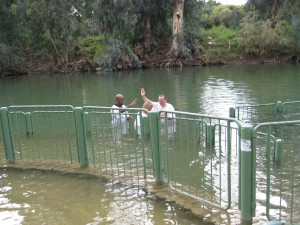
While visiting friends over a weekend, I attended church service with their family, and baptisms happened to be occurring that morning. Among the family I sat with was a six-year-old girl, who had not recalled seeing a baptism previously. “What is he doing?” she asked her grandmother, who replied that the man was being baptized. Shocked, the little girl exclaimed, “Doesn’t he know that he’s supposed to take a bath at home?!” Although there are many other differences between a bath and a baptism, private versus public is a big difference.
Baptism is a public declaration and a visual picture of what Jesus has done and is doing in someone’s life. Going under water symbolizes burial and coming up out of the water symbolizes resurrection (Romans 6:1-11). We have died to the old life and have been raised to a new life(2 Corinthians 5:16). We also have the promise of resurrection after physical death (1 Corinthians 15:3-4). We follow in the footsteps of Jesus in his obedience in baptism, and will follow in his footsteps at the final resurrection (1 Thessalonians 4:14). Also, as we use water to clean ourselves, so also the Holy Spirit has washed away our sins through the blood of Jesus (Titus 3:5). Lastly, as water is poured over us (I include immersion with my verb “poured”), so also God has “poured out” the Holy Spirit on us and in us (Acts 10:47), and united us with Christ (Galatians 3:27) and his body of believers (1 Corinthians 12:13).
Like the Lord’s Table, this a physical and spiritual act works as a powerful reminder and means of grace in the life of the believer and the witnesses of the event. Since it is meant to be a public testimony, the public, not simply the assembly of believers, should be invited to watch. Personal testimony is a powerful tool when spoken, how much more so when part of this act of obedience (Acts 2:38; Matthew 28:19).
Other posts in this series:
- The Sacraments as Means of Grace part 1: The Lord’s Supper
- The Sacraments as Means of Grace part 2: Baptism
- The Sacraments as Means of Grace part 3: Marriage
- The Sacraments as Means of Grace part 4: Ordination
- The Sacraments as Means of Grace part 5: Reconciliation
- The Sacraments as Means of Grace part 6: Anointing of the Sick
- The Sacraments as Means of Grace part 7: Confirmation
- The Sacraments as Means of Grace part 8: Acts of Mercy
©2012 Paul Tillman






